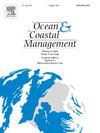Eco-engineered shorelines for biodiversity enhancement: A discrete choice experiment on citizens’ preferences
IF 5.4
2区 环境科学与生态学
Q1 OCEANOGRAPHY
引用次数: 0
Abstract
Spurred by a widened awareness of the loss of natural coastal habitats and the low biodiversity associated with traditional concrete sea defense structures, ecologically engineered shorelines (i.e., eco-shorelines) as an alternative are gaining traction amongst policymakers and environmental practitioners. However, it remains underinvestigated how society evaluates the intended outcome of transforming manmade seawalls into eco-shorelines, which may hinder their development and implementation. Using Hong Kong as a case study, this paper explores social preferences for various eco-shoreline design alternatives focusing on three key aspects: morphological changes, biodiversity enhancement, and the provision of recreational facilities, via the application of a discrete choice experiment. An online survey was conducted during October to November 2021, from which a total of 308 valid responses were received. The analytical results, based on the mixed logit models and the Equality Constrained Latent Class model, reveal that mangrove eco-shoreline is the most preferred, followed by rocky eco-shoreline and vertical eco-shoreline, while biodiversity enhancement and provision of recreational facilities are less preferred. About 54.9 % of the respondents pay little attention to the amount of donation associated with eco-shoreline implementation, corroborating a relatively strong social preference for transforming existing seawalls into eco-shorelines, irrespective of the amount of donation they might have to make. This study not only sheds additional light into the societal preference and valuation for eco-shoreline implementation, but also generates scientific evidence to inform plans and policies for concurrent coastal protection and biodiversity conservation.
增强生物多样性的生态工程海岸线:公民偏好的离散选择实验
由于人们越来越意识到自然海岸栖息地的丧失以及与传统混凝土海防结构相关的生物多样性低,生态工程海岸线(即生态海岸线)作为一种替代方案正在受到决策者和环境实践者的关注。然而,社会如何评估将人造海堤转变为生态海岸线的预期结果仍未得到充分调查,这可能会阻碍它们的开发和实施。本文以香港为例,通过离散选择实验,探讨了社会对各种生态海岸线设计方案的偏好,重点关注三个关键方面:形态变化、生物多样性增强和娱乐设施的提供。我们于2021年10月至11月进行了一项在线调查,共收到308份有效回复。基于混合logit模型和平等约束潜类模型的分析结果表明,红树林生态岸线最受青睐,其次是岩石生态岸线和垂直生态岸线,而生物多样性增强和娱乐设施的提供则较不受欢迎。约54.9%的受访者很少关注与生态岸线实施相关的捐赠金额,这证实了将现有海堤改造成生态岸线的相对强烈的社会偏好,无论他们可能需要捐赠多少。该研究不仅进一步揭示了生态海岸线实施的社会偏好和价值,而且为海岸保护和生物多样性保护的同步规划和政策提供了科学依据。
本文章由计算机程序翻译,如有差异,请以英文原文为准。
求助全文
约1分钟内获得全文
求助全文
来源期刊

Ocean & Coastal Management
环境科学-海洋学
CiteScore
8.50
自引率
15.20%
发文量
321
审稿时长
60 days
期刊介绍:
Ocean & Coastal Management is the leading international journal dedicated to the study of all aspects of ocean and coastal management from the global to local levels.
We publish rigorously peer-reviewed manuscripts from all disciplines, and inter-/trans-disciplinary and co-designed research, but all submissions must make clear the relevance to management and/or governance issues relevant to the sustainable development and conservation of oceans and coasts.
Comparative studies (from sub-national to trans-national cases, and other management / policy arenas) are encouraged, as are studies that critically assess current management practices and governance approaches. Submissions involving robust analysis, development of theory, and improvement of management practice are especially welcome.
 求助内容:
求助内容: 应助结果提醒方式:
应助结果提醒方式:


